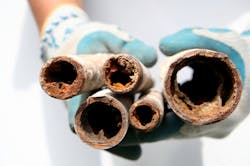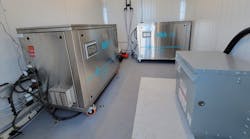1. In evaluating potential for scale formation, the inorganic salts of _________________ will exhibit the least solubility at pH of 7 to 8.
a. Calcium carbonate (CaCO3)
b. Ferrous silicate (FeSiO3)
c. Ferric hydroxide (Fe(OH)3)
d. Silica (Si(OH)4)
2. What concentration of salts might one expect to find at a reverse osmosis (RO) membrane surface, when 1,000 milligrams per liter (mg/L) are in the feedwater, the RO system operates with a 50-gallons-per-day (gpd) feedwater flow rate and a 40 gpd concentrate or reject flow rate, and the concentration of salts at the membrane surface (concentration polarization) can be assumed to be 20 percent higher than that in the bulk concentrate stream because of less immediate diffusion back to the bulk stream of the salts left behind as water permeates through the membrane?
a. 2,000 mg/L
b. 1,500 mg/L
c. 1,250 mg/L
d. 1,200 mg/L
3. What type of scales precipitate and form most quickly once its solubility limit has been reached?
a. Calcium carbonate (CaCO3)
b. Calcium sulfate (CaSO4)
c. Silica si ((OH)4)
d. Barium sulfate (BaSO4)
4. What is one way to prevent calcium carbonate scale formation in an RO system?
a. Operate at a low permeate flow recovery
b. Remove water hardness in RO pretreatment
c. Inject acid in the RO feed stream
d. Inject a scale inhibitor in the RO feed stream
e. All of the above
5. What is the name of a cycle in a water softener operation that removes suspended solids and resin fines that have been accumulated in the resin bed?
a. Brining
b. Slow displacement rinse
c. Fast rinse
d. Backwash
6. The desired expansion for a softener resin during backwash is what percent of the bed depth?
a. 10
b. 20
c. 50
d. 200
7. What is the approximate time required for filter and water softener backwashing?
a. 10 minutes
b. 30 minutes
c. 60 minutes
d. 90 minutes
8. If a set backflow rate (5 gallons per minute (gpm) for example) causes a resin bed expansion of 50 percent of bed depth when the water temperature is 40ºF, what will the bed expansion be at the same flow rate setting if the water temperature warms to 60ºF?
a. 50 percent of bed depth
b. 100 percent of bed depth
c. 30 percent of bed depth
d. 10 percent of bed depth
9. What two water softener operational cycles utilize the same flow rate of about 1 gpm or less per cubic foot of resin?
a. Brining and slow rinse
b. Backwash and fast rinse
c. Fast rinse and service
d. Service and backwash
10. What is/are example(s) of water softening over acid injection to prevent scale formation in RO membrane elements?
a. Eliminating the possibility of precipitating other insoluble salts with polyvalent cations, such as sulfates and phosphates
b. Iron removal
c. Manganese removal
d. All of the above
Answers
1. c. Calcium carbonate is perhaps the most common and most abundant scale forming compound from natural waters, and as pH and/or temperature rises, it becomes less soluble in water. However, calcium compounds, barium, strontium, silica and silicates are slightly soluble in most natural waters. Metals such as ferric iron (Fe3+), manganic manganese (Mn3+ or Mn4+) and aluminum (Al3+) are insoluble. If present in a RO feed water, for example, these three metals should be pre-filtered to prevent crystallization and precipitation (fouling) on the RO membrane. It is usually necessary to consider silicate solubilities only if the pH will be greater than 8.
2. b. Salt concentrations in RO concentrate can be estimated by the following formula: concentration factor = concentration polarization ÷ (1-recovery). Concentration polarization in this case is 1.20, or 20 percent greater salt concentration at the membrane surface. Recovery is permeate flow rate ÷ feed flow rate or 10 gpd ÷ 50 gpd or 0.20. Therefore, from 1,000 mg/L in the feedwater, the concentration of salts at the membrane surface can be estimated to be 1,000 mg/L x [1.20 ÷ (1-0.20)] = 1,500 mg/L.
3. a. Non-carbonate salts tend to form crystals and precipitate more slowly than carbonate salts. When a RO system is continually displacing its water, often little concern arises about a non-carbonate salt if it is only on the edge of its solubility. It will likely be washed out of the RO membrane element before a crystal large enough to fall out of suspension can be formed.
4. e. For small point-of-use RO systems, scale formation can often be prevented by simply operating the system at less than 30 percent permeate flow recovery to minimize the concentration of salts in the concentrate. The most certain way to prevent calcium carbonate scale is to remove water hardness in the RO feedwater with ion exchange water softening. Acid injection converts bicarbonates to carbon dioxide and also increases the solubility of most metals including CaCO3 due to the lower pH. Scale inhibitors injected in the RO slow the formation of scale.
5. d.
6. c.
7. a.
8. c. If water warms in summer months, backflow rates may need to increase to maintain 50 percent bed expansion. As water temperature drops during winter, care should be taken to not backwash resin out through the top of the unit.
9. a.
10. d.


